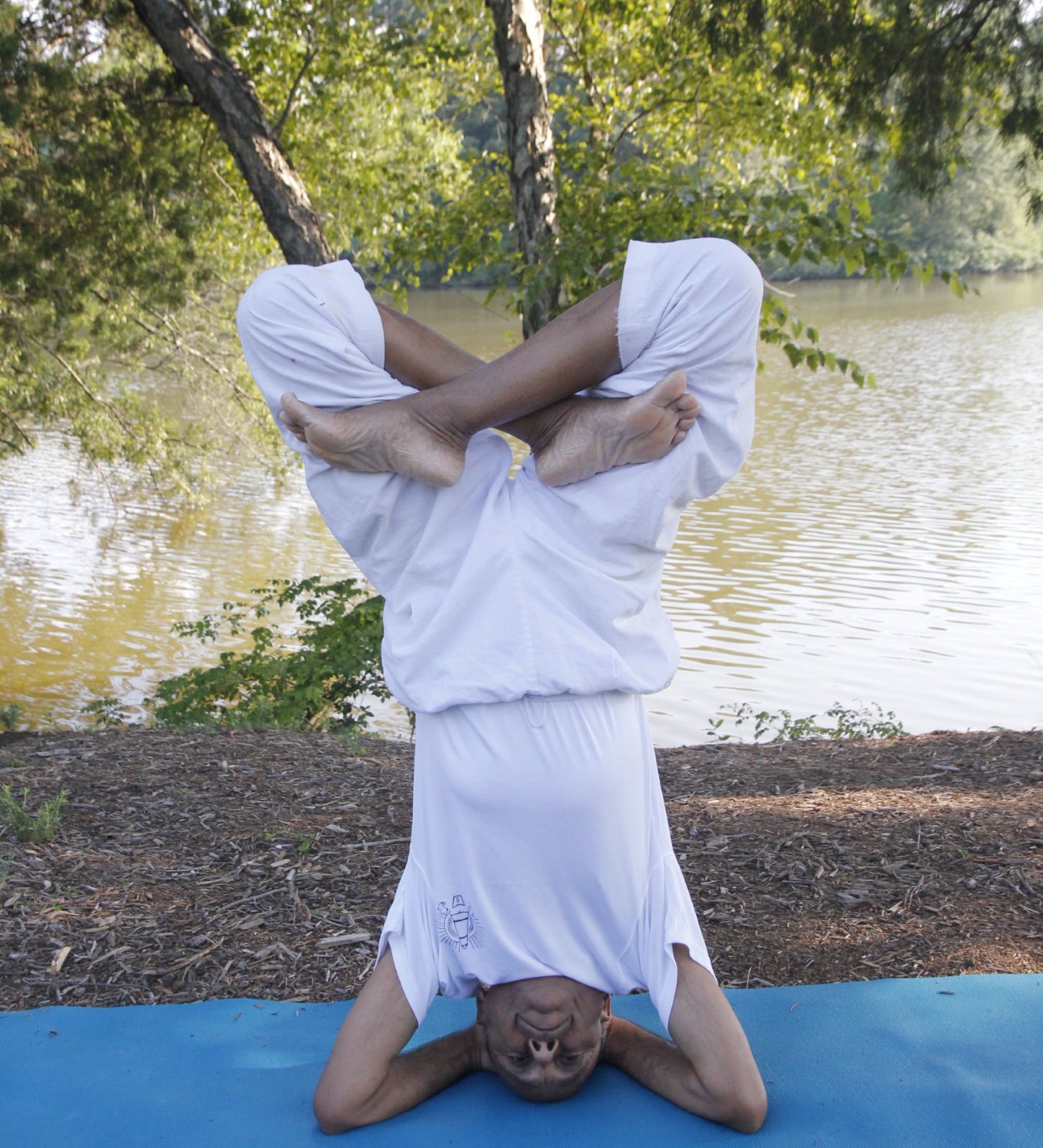
Shirsha-Padmasana (Headstand)
My yoga training began in my early childhood while watching my father practice a few yoga poses every morning. I started practicing these poses myself in my late teens. Essentially this routine consisted of a few warm-up stretches and some simple asanas like forward and back bends and some triangle type poses. One of the main asanas that my father practiced regularly was the Shirshasana (head stand). He used to stay in this pose for about ten minutes. My father always talked about this incidence while he was travelling from India to UK in a ship, a 21-day journey. While on the ship he would practice his shirshasana every morning out on the deck. People would later come by and tell him, “what an extraordinary feat! We have trouble standing on our feet on this boat and here you are standing on your head!”.
Based on what I picked up from my father, and subsequently from friends and a couple of books, I developed my own routine which I continued to practice in later years. During the early 90s I started teaching simple yoga postures to some of my family members and friends. Realizing that I was able to help them with some of their minor health-related problems through the practice of yoga, I decided to go for a formal teacher training program so I could impact the lives of many more. In the summer of 1996, I completed the Teacher Training program in the Integral Hatha Yoga style at the Swami Satchidananda Ashram in Yogaville, VA. Since then I have constantly endeavored to increase my yoga knowledge and teaching skills and have completed other training courses. Here is a list of the yoga-related training courses that I have attended:
- Basic Teacher Training program in the Integral Hatha Yoga style at the Swami Satchidananda Ashram in Yogaville, VA – August 1996 (4 weeks). This was a comprehensive and intensive residential certification program. This program consisted of instruction and practice in asana, pranayama, relaxation, meditation, Karma yoga (seva), anatomy and physiology, diet and nutrition, Yoga Sutras of Patanjali and more.
- “Yoga Vedanta Philosophy” – March-April 2006 (8 weeks). This was a two-month course offered by the Divine Life Society at the Swami Sivananda Ashram in Rishikesh, India. Topics covered included The Bhagavad Gita, Upanishads (with Ishopanishad in depth), Yoga Sutras of Patanjali, ‘Shad-Darshan’ – the six systems of Indian Philosophy, History of Western Philosophy, and Narada Bhakti Sutra. The course was taught both by resident swamis of the ashram who were extremely knowledgeable, as well as a couple of renowned invited professors. The course helped me gain a much deeper understanding of the Yogic philosophy as well as establish a well-grounded personal daily routine which includes asana, pranayama, meditation and svadhyaya (study of scriptures). I found the experience of living at the ashram (including waking up at 4 AM each morning) highly enriching.
- Prenatal Yoga certification course at the Swami Satchidananda Ashram in Yogaville, VA – June 2006 (10 days). The course included a detailed understanding of the anatomy and physiology of pregnancy and how to tailor a yoga program to suit the needs of women during various stages of pregnancy.
- Stress Management certification course at the Swami Satchidananda Ashram in Yogaville, VA – July 2006 (10 days).
- Cardiac Yoga (yoga for people with heart-related problems) certification course at the Swami Satchidananda Ashram in Yogaville, VA – July 2007 (10 days)
- Yoga philosophy course at the Darshan Yoga Mahavidyalaya in Gujrat, India – March 2008 (8 days). The course was conducted at an ashram in a very peaceful, serene environment and included discussion on the Yoga Sutra of Patanjali, Sankhya philosophy and Upanishads.
As a part of my ongoing ‘svadhyaya’ (self study), I have been participating in a Bhagavad Gita home study program for many years. During these weekly group sessions, we study and discuss the commentary on the Bhagavad Gita by various well-known authors. Since about 2002, I have been learning the Sanskrit language, the language in which all the yogic scriptures including the Yoga Sutras of Patanjali, Bhagavad Gita, Vedas, Upanishads etc. are written. I am deeply influenced by the yoga philosophy as expounded by Patanjali in his Yoga Sutras. In order to understand the philosophy of yoga better, I currently facilitate a Study Group for Yoga Sutras of Patanjali which meets twice a month. I continuously strive to develop a deeper understanding of the underlying principles of the philosophy and incorporate the guidelines of the eight limbs of yoga (ashtanga yoga), including the yamas and niyamas (moral and ethical principles), into my day-to-day life. I also endeavor to sprinkle small doses of these priciples into my yoga classes as well.
Recent Comments